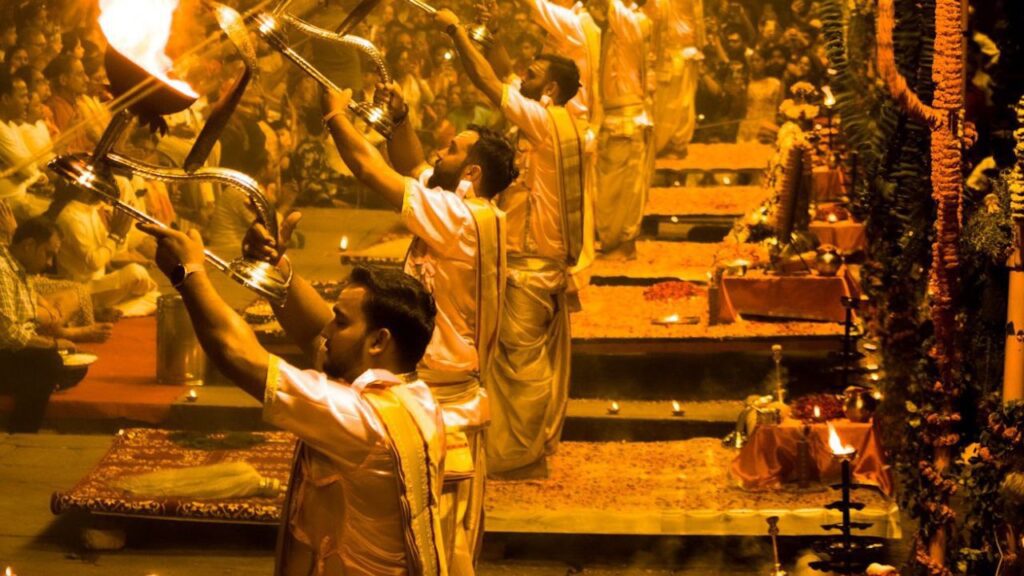India’s religious and spiritual landscape is not only a cornerstone of its cultural identity but also a rapidly expanding economic sector. Deeply intertwined with daily life, festivals, and traditions, the spiritual economy spans temples, pilgrimages, rituals, devotional products, and increasingly, digital platforms that connect faith with modern lifestyles.
As both domestic demand and global interest in India’s spiritual heritage rise, the sector is evolving from an informal, tradition-driven domain into a structured market with strong growth potential over the next decade.
Market Size & Forecasts
India’s religious and spiritual economy is witnessing robust growth. Valued at approximately USD 58–65 billion in 2024, the market is projected to grow significantly, reaching between USD 135 billion to USD 156 billion by 2034.
This translates to a compound annual growth rate (CAGR) of around 7.5% to 10.3% over the forecast period. The sector encompasses pilgrimage tourism, puja services, religious merchandise, astrology, devotional media, and increasingly, digital spiritual platforms.
Key Drivers Fueling Growth
1. Cultural Continuity & Demographics
India’s vast and deeply spiritual population fuels consistent demand for religious rituals, festivals, pilgrimage travel, and spiritual goods. With over 1.4 billion people, of whom a significant majority engage in daily spiritual or religious practices, the spiritual economy enjoys a stable and embedded role in Indian society.
2. Religious Tourism & Infrastructure Development
Religious tourism is one of the most significant contributors to the market. Popular destinations such as Varanasi, Ayodhya, Tirupati, Shirdi, and Amritsar attract millions annually.
Government initiatives aimed at enhancing infrastructure, like the Swadesh Darshan and PRASHAD schemes, have significantly improved connectivity and visitor facilities. States like Uttar Pradesh are targeting hundreds of millions of religious tourists over the next decade, with major investments planned in temple towns and spiritual circuits.
3. Rise of Digital & Faith-Tech Platforms
Technology is transforming how Indians engage with spirituality. A growing number of startups now offer online puja services, virtual darshan, livestreams of temple rituals, AI-based astrology, and spiritual wellness apps. These platforms make spiritual experiences more accessible, especially for urban residents, overseas Indians, and the tech-savvy younger generation.
4. Modern Consumption Trends
With increasing disposable incomes, consumers are spending more on premium spiritual products like curated puja kits, hand-crafted idols, natural incense, spiritual home decor, and eco-conscious festival items. Religious gifts, devotional books, and subscription-based spiritual services are also growing in popularity.
Emerging Trends to Watch
1. Digitized Convenience
Spiritual e-commerce, doorstep delivery of religious goods, and on-demand puja services are becoming commonplace. This shift is meeting the demand for convenience and time-saving alternatives, especially among working professionals and NRI customers.
2. Eco-Friendly Spirituality
Environmentally friendly spiritual practices are gaining traction. Products like biodegradable Ganesh idols, herbal havan samagri, recycled paper scriptures, and plant-based oils reflect rising eco-consciousness within faith-based consumption.
3. Wellness-Infused Spirituality
A growing fusion between wellness and spirituality is driving interest in meditation retreats, yoga ashrams, spiritual detox programs, and holistic healing centers. This blend attracts not only domestic participants but also global tourists seeking spiritual rejuvenation in India.
4. Youth & Global Diaspora Engagement
Younger audiences and the Indian diaspora are embracing digital spirituality. Livestream rituals, apps with AI-guided spiritual routines, and interactive devotion platforms are helping them stay connected to traditional values in a format aligned with modern lifestyles.
Challenges Facing the Sector
- Fragmentation and Informality: The market remains largely unorganized, with inconsistent service quality and lack of standardization in spiritual products and experiences.
- Trust and Authenticity: There is a growing need for credible platforms and certified products to ensure authenticity in a sector where spiritual trust is paramount.
- Seasonal Demand Patterns: Revenue tends to fluctuate, peaking during festivals and pilgrimage seasons, making year-round growth strategies essential.
- Regulatory and Cultural Sensitivities: Religious services must navigate complex legal, ethical, and cultural boundaries, especially when scaling or digitizing traditional practices.
Outlook: 2025–2034
The Indian religious and spiritual market is poised for sustained, diversified growth. Key factors such as rising tourism, digitization, premiumization of spiritual products, and government support will continue driving momentum. The sector is likely to become more structured, tech-integrated, and environmentally conscious over the next decade.
Looking forward, players who can balance tradition with innovation- offering authentic, accessible, and ethical spiritual experiences- will lead the next phase of growth in this vibrant and deeply rooted sector.

